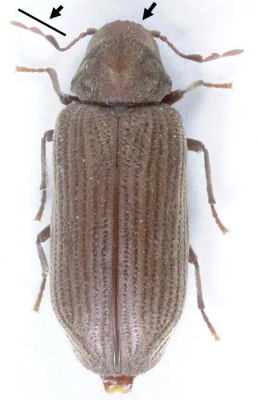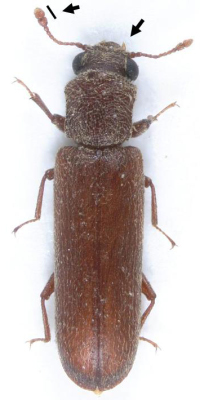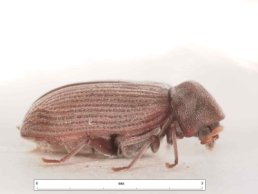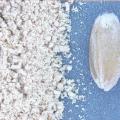Lyctidae Family
Who are they?
In France, that Coleoptera family comprises less than 10 species that are exclusive wood-eaters at the larval stage.
These dull-coloured and often dark-coloured insects (ranging from chestnut brown to black) are between 2 and 6 mm long.
In profile, the species of that family are rather very flat compared to Anobiidae species.
Characteristic habitus of Lyctidae and Anobiidae
Anobidae family (Anobium punctatum) and Lyctidae family (Lyctus brunneus)




Anobium punctatum Lyctus brunneus
Main morphological characteristics and faunistic data
Lyctidae are close relatives of Anobiidae (woodworms) and Bostrichidae (lesser grain borers) ; those 2 families also comprise many xylophagous species that are also found in museum premises.
The Lyctidae family can be identified thanks to the following features, amongst others :
- the head is clearly visible in Lyctidae ; it is not visible from above in Anobiidae for it is hidden under the thorax ; it is more or less visible, depending on genera and species, in Bostrichidae,
- Lyctidae hind coxa have furrows for femur insertion; Bostrichidae don't
- the antennal club is composed of two articles in Lyctidae, whereas it is composed of three articles in Anobiidae and Bostrichidae.
Lyctidae larvae mainly live in deadwood from deciduous trees. Several of them are dangerous enemies of worked wood (furniture, woodwork, art works…).
A few species are very common in houses (Lyctus brunneus et Lyctus linearis) and in museum premises.
Biological facts and damages
The larvae are the ones that cause damage by digesting wood constituents. Adults do not feed and live only a few weeks’ time.
Females lay their eggs in wood cracks and crevices (never on a flat surface), and the larvae get into the depths of the material by boring numerous galleries.
The larval cycle usually lasts between 6 and 12 months, depending on climatic conditions and on the extent to which the wood has been altered (cycle length is reduced in case of an attack by lignin-degrading fungi, for example).
Unlike Anobiidae, Lyctidae can only infest wood whose vessels are big ennough (> 0.05 mm) for the females to be able to introduce their ovipostor during the egg-laying period.
Moreover, the wood has to contain high levels of starch (1 to 1.5% minimum, 3 to 4% optimum). That is why they are called amylophage or amylophile insects.
The larvae cannot digest cellulose or hemicellulose A, but they can digest starch, sucrose, maltose, lactose and hemicellulose B.
Infestation degree and development rate therefore very much depend on the quantities of starch and also on the contents of soluble sugars, proteins and vitamins present in the wood.
Larvae can develop in the wood if its water content ranges between 8 and 30%.The larval development cycle is all the shorter as wood water content is high.
The insects’ presence and activity can easily be noticed thanks to the adults’ emergence (or flight) holes (they are between 1 and 2 mm in diameter) and thanks to the presence of powder-like bore-dust found at the level (or at the foot) of flight holes and resulting from wood digestion by larvae.
Boredust size and shape are perfectly characteristic of the species of that family (cf. Photo 1).
The bore-dust of Anobiidae is gritty, whereas the bore-dust of Lyctidae looks like flour in its aspect and granulometry. It is a very fine bore-dust called “fleur de farine” (meal flower).

Photo 1 : characteristic bore-dust of Lyctidae :
Very fine flour-like aspect
Unlike adult Bostrichidae, adult Lyctidae and Anobiidae do not feed throughout their short lives.
The species that are most detrimental to worked wood and crafted wood (furniture, works of art, woodworks…) are Lyctus linearis and Lyctus brunneus, which are widespread species.
That family also comprises Trogoxylon impressum, which is rarely and only occasionally found, but can cause important damage to wood.
